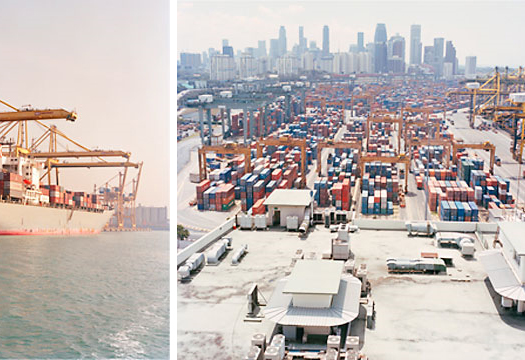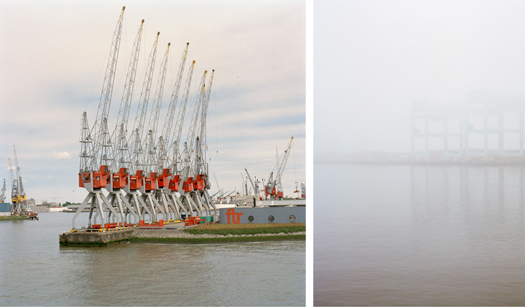
[all photographs from Andrea Frank’s series “Ports and Ships”]
1. Dave Roberts reviews two books on the future of automotive transportation — Traffic and Reinventing the Automobile — in the American Prospect, primarily discussing “USVs”, the descendant of MIT’s CityCar. Roberts’ review explains why mammoth is so excited about CityCar as an architectural tool:
Where the vision tips over from cool-for-car-nerds into mind-blowing is not in the car itself but in how it’s connected to the power grid, other cars, and the city around it. Most cars are parked about 95 percent of the time. All those idle batteries add up to considerable energy-storage capacity. Having a place to store electricity is important because America’s power system, like its cars and parking infrastructure, is overbuilt, scaled to meet peak demand. With a place to store surplus electricity when it’s made and release it when it’s needed, system engineers can “shave the peak.”
The authors envision USVs converging with other technologies — rooftop solar panels, small wind turbines, geothermal heat pumps, cogeneration systems, large-scale batteries, smart grids — to create a new kind of power system in which cities are generating, managing, and distributing all or most of their own electricity. This kind of local, distributed power system will eliminate the high cost of transmission lines bringing power from a distance, reduce smog and other particulate pollution, eliminate dependence on foreign energy, and, at the limit, make possible carbon-neutral cities…
[A] “Mobility Internet” could lead to the same kind of innovation unleashed by the Internet itself. Among other things, it could enable a revolution in civic management of road, parking, and power services. Currently the large majority of roads and a great deal of parking is free, and as any economist will tell you, an unpriced resource will be overused. Sure enough, road and parking demand frequently exceed supply, leading to congestion, a good chunk of which, Traffic reminds us, is created by people driving around looking for parking (“parking foreplay” also causes one in five urban collisions). Although power isn’t free, it’s generally sold at a flat rate, leaving consumers no way of knowing when it’s most valuable.
Toll roads and congestion charges are crude attempts to change the situation. Once the devices that consume road, parking, and power services are connected to the Internet, however, cities can institute variable, real-time, citywide pricing for those resources, based on the balance of supply and demand moment to moment. This could radically increase the productivity of resource use, compensating at least in part for the expense of building these systems. Cities would become more like organisms, their subsystems controlled and coordinated by a unified nervous system. (Water and sewage systems could be integrated to the digital grid as well and even used as backup energy storage — but that’s another story.)
Ryan Avent picks up on the Roberts article, discussing regulatory barriers to innovation in automotive transport and then clarifying his thoughts in a second post.

[Modelling global shipping routes, from Pablo Kaluza et al.’s “The complex network of global cargo ship movements”, via Infectious Greed]
2. Meanwhile, cities on the West Coast prepare infrastructure for the impending arrival of mass-produced electric cars.
3. Back on the East Coast, the Obama administration approves financial aid for the construction of the first two new nuclear reactors in the United States since the seventies. mammoth applauds, and hopes that we can look forward to visiting an American La Hague in a decade or two.

4. The Danish shipping giant Maersk is pioneering the development of “super slow shipping”, or the intentional operation of container ships at lower speeds to realize greater energy efficiency, decreasing both fuel consumption (which is profitable) and carbon emissions.
5. Chicago and the Army Corps of Engineers ponder undoing the reversal of the Chicago River, in a “last-ditch effort to prevent the Asian carp from decimating the $7 billion Great Lakes fishing industry”; the de-reversal is heavily opposed by the Great Lakes shipping industry, and would require re-thinking Chicago’s constructed urban hydrology, as flood control measures depend on the current configuration to deal with peak flooding.
[link 2 via @bldgblog, link 5 via Delta National Park]

